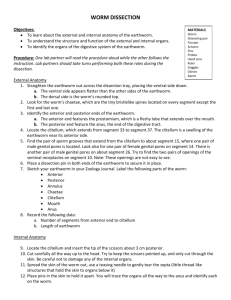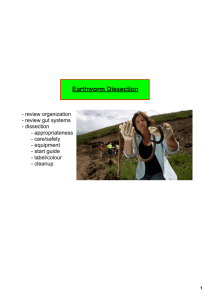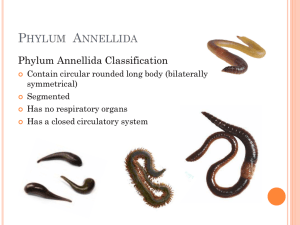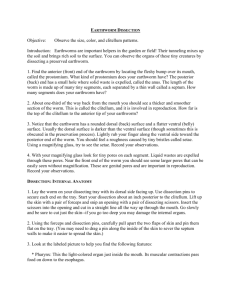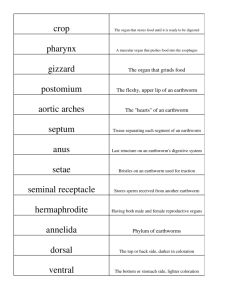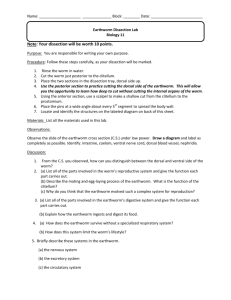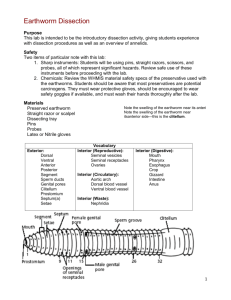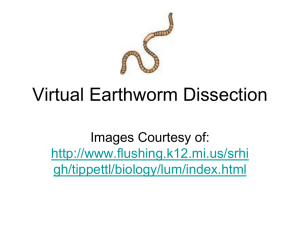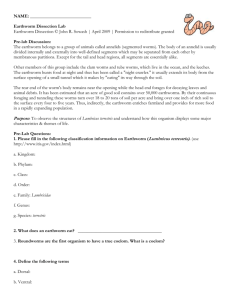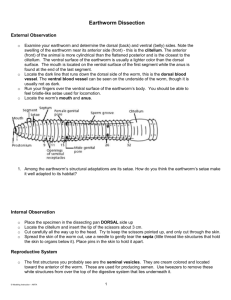Lab: Earthworm Dissection
advertisement
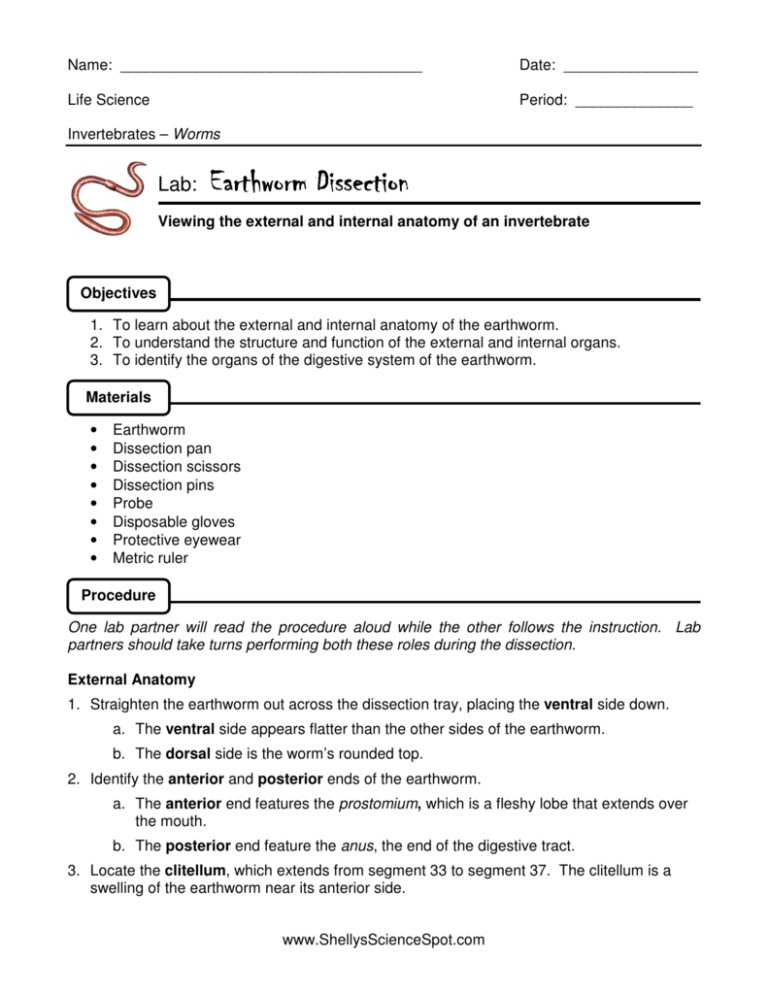
Name: ____________________________________ Date: ________________ Life Science Period: ______________ Invertebrates – Worms Lab: Earthworm Dissection Viewing the external and internal anatomy of an invertebrate Objectives 1. To learn about the external and internal anatomy of the earthworm. 2. To understand the structure and function of the external and internal organs. 3. To identify the organs of the digestive system of the earthworm. Materials • • • • • • • • Earthworm Dissection pan Dissection scissors Dissection pins Probe Disposable gloves Protective eyewear Metric ruler Procedure One lab partner will read the procedure aloud while the other follows the instruction. Lab partners should take turns performing both these roles during the dissection. External Anatomy 1. Straighten the earthworm out across the dissection tray, placing the ventral side down. a. The ventral side appears flatter than the other sides of the earthworm. b. The dorsal side is the worm’s rounded top. 2. Identify the anterior and posterior ends of the earthworm. a. The anterior end features the prostomium, which is a fleshy lobe that extends over the mouth. b. The posterior end feature the anus, the end of the digestive tract. 3. Locate the clitellum, which extends from segment 33 to segment 37. The clitellum is a swelling of the earthworm near its anterior side. www.ShellysScienceSpot.com 4. Place a dissection pin in both ends of the earthworm to secure it in place. 5. Sketch your earthworm in the space below. Label the following parts of the worm: • • • • • Anterior Posterior Clitellum Mouth Anus 6. Record the following data: a. Number of segments from anterior end to clitellum: ____________ b. Length of earthworm: ____________ cm Internal Anatomy 7. Locate the clitellum and insert the tip of the scissors about 3 cm posterior. 8. Cut carefully all the way up to the head. Try to keep the scissors pointed up, and only cut through the skin. Be careful not to damage any of the internal organs. 9. Spread the skin of the worm out, use a teasing needle to gently tear the septa (little thread like structures that hold the skin to organs below it) 10. Place pins in the skin to hold it apart. 11. The digestive system starts at the mouth. You will trace the organs all the way to the anus and identify each on the worm. a. Find the mouth opening, the first part after the mouth is the pharynx, you will see stringy things attached to either side of the pharynx (pharyngeal muscles). b. The esophagus leads from the pharynx but you probably won’t be able to see it, since it lies underneath the heart. c. You will find two structures close to the clitellum. First in the order is the crop, followed by the gizzard. The gizzard leads to the intestine, which is as long as the worm and ends at the anus. www.ShellysScienceSpot.com 12. Describe the function of each digestive organ and label the diagram below: Digestive Organ Function Crop Mouth Pharynx Intestine Gizzard Anus Esophagus Pharyngeal Muscles 13. Use your scissors to open the crop and gizzard. Examine the contents of these organs. 14. Clean your work area as directed by your teacher. Post-Lab Answer the following questions in complete sentences. 1. In which organ (crop or gizzard) did you find the contents to be most ground up and why? ________________________________________________________________________ ________________________________________________________________________ ________________________________________________________________________ 2. How could you find out whether an earthworm eats soil or not? ________________________________________________________________________ ________________________________________________________________________ ________________________________________________________________________ www.ShellysScienceSpot.com 3. Trace the parts of the digestive tract through which food passes. ________________________________________________________________________ ________________________________________________________________________ ________________________________________________________________________ 4. Your dissection of the earthworm did not go beyond segment 32. What would you observe if you dissected the remainder of the worm to its posterior end? ________________________________________________________________________ ________________________________________________________________________ ________________________________________________________________________ 5. In a short paragraph, explain what you learned or found interesting about this dissection. ________________________________________________________________________ ________________________________________________________________________ ________________________________________________________________________ ________________________________________________________________________ ________________________________________________________________________ ________________________________________________________________________ ________________________________________________________________________ ________________________________________________________________________ ________________________________________________________________________ ________________________________________________________________________ ________________________________________________________________________ ________________________________________________________________________ ________________________________________________________________________ www.ShellysScienceSpot.com


